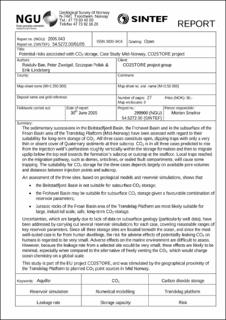| dc.contributor.author | Bøe, Reidulv | |
| dc.contributor.author | Lindeberg, Erik | |
| dc.contributor.author | Szczepan, Polak | |
| dc.contributor.author | Zweigel, Peter | |
| dc.date.accessioned | 2020-07-15T07:50:03Z | |
| dc.date.available | 2020-07-15T07:50:03Z | |
| dc.date.issued | 2005 | |
| dc.identifier.issn | 0800-3416 | |
| dc.identifier.uri | https://hdl.handle.net/11250/2664936 | |
| dc.description.abstract | The sedimentary successions in the Beitstadfjord Basin, the Frohavet Baisn and in the subsurface of the Froan Basin area of the Trøndelag Platform (Mid-Norway) have been assessed with regard to their suitability for long-term storage of CO2. All three cases constitute open, dipping traps with only a very thin or absent cover of Quaternary sediments at their subcrop. CO2 is in all three cases predicted to rise from the injection well's perforation roughly vertically within the storage formation and then to migrate updip below the top seal towards the formation's subcrop or outcrop at the seafloor. Local traps reached on the migration pathway, such as domes, anticlines, or sealed fault compartments, will cause some trapping. The suitability for CO2 storage for the three cases depends largely on available pore volumes and distances between injection points and subcrop.\r(Forkortet)\rSINTEF report no. 54.5272.00\/01\/05 | |
| dc.language.iso | eng | |
| dc.relation.ispartofseries | NGU-Rapport (2005.043) | |
| dc.rights | Navngivelse 4.0 Internasjonal | |
| dc.rights.uri | http://creativecommons.org/licenses/by/4.0/deed.no | |
| dc.subject | MARINGEOLOGI | |
| dc.subject | DEPONI | |
| dc.subject | MODELLFORSØK | |
| dc.subject | RESERVOAR | |
| dc.title | Potential risks associated with CO2 storage, Case Study Mid-Norway, CO2STORE project | |
| dc.type | Report | |
| dc.description.localcode | 52565 | |
| dc.source.pagenumber | 28 s. ; kr | |
| dc.relation.project | (299900) CO2 STORE | |

